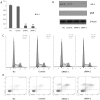Down-regulation of AP-4 inhibits proliferation, induces cell cycle arrest and promotes apoptosis in human gastric cancer cells
- PMID: 22615908
- PMCID: PMC3353913
- DOI: 10.1371/journal.pone.0037096
Down-regulation of AP-4 inhibits proliferation, induces cell cycle arrest and promotes apoptosis in human gastric cancer cells
Abstract
Background: AP-4 belongs to the basic helix-loop-helix leucine-zipper subgroup; it controls target gene expression, regulates growth, development and cell apoptosis and has been implicated in tumorigenesis. Our previous studies indicated that AP-4 was frequently overexpressed in gastric cancers and may be associated with the poor prognosis. The purpose of this study is to examine whether silencing of AP-4 can alter biological characteristics of gastric cancer cells.
Methods: Two specific siRNAs targeting AP-4 were designed, synthesized, and transfected into gastric cancer cell lines and human normal mucosa cells. AP-4 expression was measured with real-time quantitative PCR and Western blot. Cell proliferation and chemo-sensitivity were detected by CCK-8 assay. Cell cycle assay and apoptosis assay were performed by flow cytometer, and relative expression of cell cycle regulators were detected by real-time quantitative PCR and Western blot, expression of the factors involved in the apoptosis pathway were examined in mRNA and protein level.
Results: The expression of AP-4 was silenced by the siRNAs transfection and the effects of AP-4 knockdown lasted 24 to 96 hrs. The siRNA-mediated silencing of AP-4 suppressed the cellular proliferation, induced apoptosis and sensitized cancer cells to anticancer drugs. In addition, the expression level of p21, p53 and Caspase-9 were increased when AP-4 was knockdown, but the expression of cyclin D1, Bcl-2 and Bcl-x(L) was inhibited. It didn't induce cell cycle arrest when AP-4 was knockdown in p53 defect gastric cancer cell line Kato-III.
Conclusions: These results illustrated that gene silencing of AP-4 can efficiently inhibited cell proliferation, triggered apoptosis and sensitized cancer cells to anticancer drugs in vitro, suggesting that AP-4 siRNAs mediated silencing has a potential value in the treatment of human gastric cancer.
Conflict of interest statement
Figures







Similar articles
-
[Effect of silencing AEG-1 with small interfering RNA on the proliferation and cell cycle of gastric carcinoma SGC-7901 cells].Zhonghua Zhong Liu Za Zhi. 2013 Jan;35(1):22-7. doi: 10.3760/cma.j.issn.0253-3766.2013.01.005. Zhonghua Zhong Liu Za Zhi. 2013. PMID: 23648295 Chinese.
-
Neuronal pentraxin II (NPTX2) hypermethylation promotes cell proliferation but inhibits cell cycle arrest and apoptosis in gastric cancer cells by suppressing the p53 signaling pathway.Bioengineered. 2021 Dec;12(1):1311-1323. doi: 10.1080/21655979.2021.1915658. Bioengineered. 2021. PMID: 33896384 Free PMC article.
-
Silencing of the IKKε gene by siRNA inhibits invasiveness and growth of breast cancer cells.Breast Cancer Res. 2010;12(5):R74. doi: 10.1186/bcr2644. Epub 2010 Sep 23. Breast Cancer Res. 2010. PMID: 20863366 Free PMC article.
-
siRNA-based therapy for gastric adenocarcinoma: what's next step?Pathol Res Pract. 2024 Jun;258:155328. doi: 10.1016/j.prp.2024.155328. Epub 2024 Apr 23. Pathol Res Pract. 2024. PMID: 38744002 Review.
-
The role and regulation of Maf proteins in cancer.Biomark Res. 2023 Feb 7;11(1):17. doi: 10.1186/s40364-023-00457-w. Biomark Res. 2023. PMID: 36750911 Free PMC article. Review.
Cited by
-
Deletion of the transcriptional regulator TFAP4 accelerates c-MYC-driven lymphomagenesis.Cell Death Differ. 2023 Jun;30(6):1447-1456. doi: 10.1038/s41418-023-01145-w. Epub 2023 Mar 9. Cell Death Differ. 2023. PMID: 36894688 Free PMC article.
-
Polyphenolic compounds from Korean Lonicera japonica Thunb. induces apoptosis via AKT and caspase cascade activation in A549 cells.Oncol Lett. 2017 Apr;13(4):2521-2530. doi: 10.3892/ol.2017.5771. Epub 2017 Feb 23. Oncol Lett. 2017. PMID: 28454429 Free PMC article.
-
The PRMT5/WDR77 complex regulates alternative splicing through ZNF326 in breast cancer.Nucleic Acids Res. 2017 Nov 2;45(19):11106-11120. doi: 10.1093/nar/gkx727. Nucleic Acids Res. 2017. PMID: 28977470 Free PMC article.
-
Nano - drug Delivery of Apoptosis Activator 2 to AGS Cells by Liposomes Conjugated with Anti-TROP2 Antibody.N Am J Med Sci. 2012 Nov;4(11):582-5. doi: 10.4103/1947-2714.103319. N Am J Med Sci. 2012. PMID: 23181231 Free PMC article.
-
MYCN promotes neuroblastoma malignancy by establishing a regulatory circuit with transcription factor AP4.Oncotarget. 2016 Aug 23;7(34):54937-54951. doi: 10.18632/oncotarget.10709. Oncotarget. 2016. PMID: 27448979 Free PMC article.
References
-
- Correia M, Machado JC, Ristimaki A. Basic aspects of gastric cancer. Helicobacter. 2009;14(Suppl 1):36–40. - PubMed
-
- Alberts SR, Cervantes A, van de Velde CJ. Gastric cancer: epidemiology, pathology and treatment. Ann Oncol. 2003;14(Suppl 2):ii31–36. - PubMed
-
- Catalano V, Labianca R, Beretta GD, Gatta G, de Braud F, et al. Gastric cancer. Crit Rev Oncol Hematol. 2009;71:127–164. - PubMed
Publication types
MeSH terms
Substances
LinkOut - more resources
Full Text Sources
Medical
Research Materials
Miscellaneous

